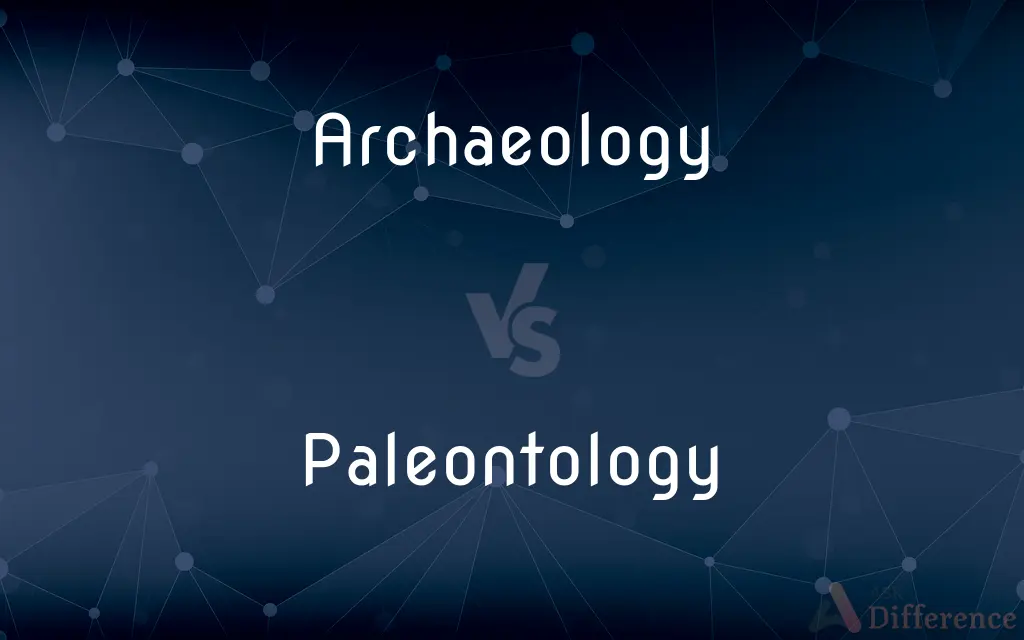Archaeology vs. Paleontology — What's the Difference?
Edited by Tayyaba Rehman — By Maham Liaqat — Updated on March 25, 2024
Archaeology involves the study of human history and prehistory through artifacts and remains, while paleontology focuses on the life of past geological periods as revealed by fossils.

Difference Between Archaeology and Paleontology
Table of Contents
ADVERTISEMENT
Key Differences
Archaeology is concerned with understanding human cultures, societies, and behaviors through the examination of material remains such as tools, pottery, and structures left behind by past societies. Paleontology, on the other hand, delves into the life of ancient organisms, including plants, animals, and microorganisms, through fossil evidence, ranging from dinosaur bones to ancient pollen.
While archaeologists might excavate sites to uncover artifacts, ruins, and human remains to piece together human history, paleontologists are often found at dig sites extracting fossilized remains of creatures that roamed the earth millions of years ago. This fundamental difference highlights the distinct focuses of each discipline: human activities for archaeology and ancient life forms for paleontology.
The tools and methods used in archaeology and paleontology can overlap, with both fields employing excavation techniques, but their analytical approaches and research goals differ. Archaeologists might analyze the social structure, economy, and art of ancient civilizations, whereas paleontologists could study the evolutionary history, anatomy, and ecology of extinct species.
Archaeology often intersects with history, anthropology, and sociology, considering the implications of human artifacts and settlements in understanding past human life. Paleontology intersects with biology, geology, and evolutionary science, using fossil records to understand the evolution of life and the Earth's past environments.
Despite their differences, both fields contribute significantly to our understanding of the past, whether it's the life of our human ancestors and their societies in archaeology or the broader spectrum of life on Earth in paleontology.
ADVERTISEMENT
Comparison Chart
Focus
Human history and prehistory
Life of past geological periods
Key Subjects
Artifacts, ruins, human remains
Fossils of plants, animals, and microorganisms
Objective
Understanding human cultures, societies, behaviors
Studying ancient life forms and their evolution
Methods
Excavations, artifact analysis
Fossil excavation, analysis of ancient biological data
Interdisciplinary Connections
History, anthropology, sociology
Biology, geology, evolutionary science
Key Differences
Centers on human activities
Focuses on ancient organisms
Compare with Definitions
Archaeology
The study of human activity through the recovery and analysis of material culture.
Archaeologists excavating a Neolithic site discovered pottery shards indicative of early agricultural practices.
Paleontology
The science of the life of past geological periods as known from fossil remains.
Paleontologists identified a new dinosaur species based on a nearly complete skeleton found in sedimentary rock layers.
Archaeology
Involves the examination of buildings, artifacts, and cultural landscapes.
The study of ancient road systems helped archaeologists understand trade networks between early civilizations.
Paleontology
Studies fossils to understand ancient life forms.
The discovery of fossilized pollen grains helped paleontologists reconstruct ancient climate conditions.
Archaeology
Analyzes artifacts to infer social structures, economies, and living conditions.
The analysis of inscriptions on stone tablets provided clues about the legal systems of ancient societies.
Paleontology
Examines the evolution and interaction of extinct species.
The analysis of vertebrate fossils contributed to understanding the evolutionary transition from water to land animals.
Archaeology
Collaborates with historians, anthropologists, and sociologists.
Archaeologists worked with anthropologists to interpret the societal implications of ancient communal structures.
Paleontology
Places fossils within a geological timeframe to date and contextualize biological evolution.
By dating the volcanic ash layers above and below a fossil site, paleontologists established a precise age for the fossils.
Archaeology
Aims to reconstruct past human life and societies.
Through the study of burial sites, archaeologists have uncovered insights into ancient religious beliefs.
Paleontology
Draws on biology, geology, and evolutionary science.
Paleontologists collaborated with geologists to study the impact of mass extinctions on biodiversity through geological time.
Archaeology
Archaeology or archeology is the study of human activity through the recovery and analysis of material culture. Archaeology is often considered a branch of socio-cultural anthropology, but archaeologists also draw from biological, geological, and environmental systems through their study of the past.
Paleontology
Paleontology (), also spelled palaeontology or palæontology, is the scientific study of life that existed prior to, and sometimes including, the start of the Holocene epoch (roughly 11,700 years before present). It includes the study of fossils to classify organisms and study their interactions with each other and their environments (their paleoecology).
Archaeology
The systematic study of past human life and culture by the recovery and examination of remaining material evidence, such as graves, buildings, tools, and pottery.
Paleontology
The study of the forms of life existing in prehistoric or geologic times, as represented by the fossils of plants, animals, and other organisms.
Archaeology
The study of the past by excavation and analysis of its material remains:
Paleontology
(American spelling) Study of the forms of life existing in prehistoric or geologic times, especially as represented by fossils.
Archaeology
The actual excavation, examination, analysis and interpretation.
The building's developers have asked for some archaeology to be undertaken.
Paleontology
The science which treats of the ancient life of the earth, or of fossils which are the remains of such life.
Archaeology
The actual remains together with their location in the stratigraphy.
The archaeology will tell us which methods of burial were used by the Ancient Greeks.
Paleontology
The earth science that studies fossil organisms and related remains
Archaeology
The academic subject; in the USA: one of the four sub-disciplines of anthropology.
She studied archaeology at Edinburgh University.
Archaeology
The science or study of antiquities, esp. prehistoric antiquities, such as the remains of buildings or monuments of an early epoch, inscriptions, implements, and other relics, written manuscripts, etc.
Archaeology
The branch of anthropology that studies prehistoric people and their cultures
Common Curiosities
What is the main difference between archaeology and paleontology?
The main difference lies in their focus: archaeology studies human history through artifacts and remains, while paleontology focuses on ancient life through fossils.
What types of artifacts do archaeologists study?
Archaeologists study a wide range of artifacts, including tools, pottery, artwork, and structures, to gain insights into past human societies.
Can archaeology and paleontology overlap?
While they have distinct focuses, the fields can overlap in areas like the study of early human fossils, where paleontological methods are used to understand human evolution.
Why is the study of ancient pollen important in paleontology?
Ancient pollen can reveal information about past climates, vegetation, and ecological conditions, contributing to our understanding of Earth's history.
How do paleontologists date fossils?
Paleontologists use methods like radiometric dating and stratigraphy to determine the age of fossils and place them in a geological context.
What insights can the study of burial sites provide in archaeology?
Burial sites can offer valuable insights into ancient religious beliefs, social hierarchies, and cultural practices of past societies.
What role do fossils play in understanding evolutionary biology?
Fossils provide crucial evidence for the evolution of life, showing how species have changed over time and how different organisms are related.
What interdisciplinary approaches are common in archaeology?
Archaeologists often collaborate with experts in history, anthropology, chemistry, and biology to interpret artifacts and reconstruct past human activities and environments.
How does the geological context help in paleontology?
The geological context helps paleontologists date fossils, understand the environmental conditions in which ancient organisms lived, and trace changes in Earth's history.
How do archaeologists determine the age of artifacts?
Archaeologists use dating methods such as radiocarbon dating, dendrochronology, and thermoluminescence to estimate the age of artifacts.
Share Your Discovery

Previous Comparison
Mistake vs. Fault
Next Comparison
Astrologer vs. AstrologistAuthor Spotlight
Written by
Maham LiaqatEdited by
Tayyaba RehmanTayyaba Rehman is a distinguished writer, currently serving as a primary contributor to askdifference.com. As a researcher in semantics and etymology, Tayyaba's passion for the complexity of languages and their distinctions has found a perfect home on the platform. Tayyaba delves into the intricacies of language, distinguishing between commonly confused words and phrases, thereby providing clarity for readers worldwide.














































